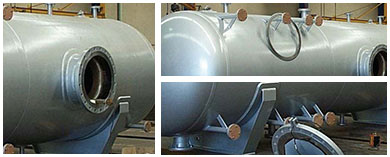
- (03) 5909 8218
- enquiry@fusionweld.com.au
Heat Exchanger Functions
February 19, 2015

There are countless terms used in mechanical engineering. They describe functions and features of complex processes, breaking down stages of that process into theoretical practices and practical concepts that are governed by physical laws. Thankfully, some examples of this verbal sparring are easy to translate. The phrase heat exchanger is one of these instances, an exception to the complex terminology rule. The wording means exactly what it appears to state, that a heat exchanger is a device designed to transfer energy from one source to another, with that power taking the form of heat, the galvanic energy that all life requires to function.
In proving that engineering can never stay simple, the science that underlies the principles of heat exchange quickly devolve into the murky realm of thermal dynamics, but we can anchor ourselves on certain incontrovertible truths. Heat exchangers used in factories, in oil refineries, and in building environmental systems, all share the same operational parameters, that of efficiently moving energy from one fluid to another, or from one fluid to a solid surface. The key in efficiently accomplishing this function lays in creating the largest possible surface area between the two mediums. In an ideal world we'd simply create enormous assemblies of flat metal, copper or some other medium with excellent thermal conductivity, and sit back to watch one-hundred percent of the energy being transferred. Unfortunately, we live in a less than ideal world, an existence where engineers have created innovative means of achieving this large surface area.
The flash point of steam driven through a gas boiler works in concert with a building heat exchanger to generate a heated airflow. Meanwhile, in the oil refinery industry, heat exchangers adopt a more dramatic operational mode. They adopt high-pressure structural components, pressurized vessels, to contain two or more fluids in a network of pipes, the methodology adopted by those clever engineers we were just talking about. Crude oil is fed through the labyrinthine tubing. Entering a furnace, the liquid is rapidly heated to activate the core fractionation process we all depend on for our refined fuels. The role of the heat exchanger at this point is to aid in the distillation process by cooling the fractions, injecting a cooler secondary liquid to exchange energy with the oil. Vaporized crude oil then liquefies and moves on to the next stage of the refinement process.
The questionable viability of the antiquated shell and tube heat exchanger in a modern oil refinery has given rise to more efficient variants with greater energy transferal coefficients. The result is the introduction of units with smaller footprints, a major requirement in an offshore oil drilling setting. Check out plate-type exchangers and the option to replace traditional tube networks with high-flux networks for more information on the future of the heat exchanger.
Contact Details
Fusion - Weld Engineering Pty Ltd
ABN 98 068 987619
1865 Frankston Flinders Road,
Hastings, VIC 3915
Ph: (03) 5909 8218
Optimized by NetwizardSEO.com.au
Recent Posts
- Compressed Hydrogen Storage Vessels: Material Selection, Design & Australian Standards
- Welding QA/QC in Oil & Gas Pressure Vessel Fabrication – Ensuring Code Compliance
- AS1210 vs ASME VIII Pressure Vessel Code: Key Differences for Australian Projects
- Mitigating Hydrogen-Induced Cracking in Pressure Vessels: Engineering and Material Strategies
- Storage Tank Solutions Australia: Field-Erected, Prefabricated & Self-Bunded Explained
- Reducing Environmental Risks: Self-Bunded Tanks in Australian Oil & Gas Operations
- Precision in Production: How Pressure Vessels Are Manufactured for Industrial Safety
- Shell & Tube Heat Exchangers: Improve Thermal Control & Energy Recovery in Petrochemical & Pharmaceutical Plants
- In-Service Inspection for Compressed Air Receivers for Power Plant Shutdown Prevention
- Power Plant Pipe Spooling Fabrication – Get Rapid, Code-Compliant Spools Ready for Installation
- Field Erected Tanks: Safe, Reliable On-Site Fuel Storage Solutions in Australia
- Custom Pressure Vessel Fabrication for Flammable Gases
Posts 2025
- Compressed Hydrogen Storage Vessels: Material Selection, Design & Australian Standards
- Welding QA/QC in Oil & Gas Pressure Vessel Fabrication – Ensuring Code Compliance
- View all articles…
Posts 2024
- Large Process Vessels: Optimising the Design for Maximum Efficiency [2025]
- Pressure Equipment Management System Installation: Detect Equipment Faults Early
- View all articles…
Posts 2023
- Pressure Piping System Inspection: A Gift of Safety for the Holidays
- Deaerator Inspections by Fusion-Weld Engineering and How They Reduce System Downtime
- View all articles…
Posts 2022
- How Fusion Weld Keeps Up With AS-NZS ISO 9001:2008 Standard
- Boiler Equipment Safety Inspection During the Summer Season
- View all articles…
Posts 2021
- Avoid These Factors and Practices that Contribute to Sealing Damage in Pressure Vessels
- Do's And Don'ts Of Industrial Boiler Inspection And Maintenance From Fusion-Weld
- View all articles…
Posts 2020
- What are the Risks and Hazards Involved in Pressure Vessel Equipment?
- How to Know if Your Pressure Equipment Needs Repair or Replacement?
- View all articles…
Posts 2019
- Factors that Contribute to Pressure Vessel Failure
- Pressure Vessel Regulations in Australia: What are the Mandatory Requirements?
- View all articles…
Posts 2018
- Pros and Cons of Spherical vs. Cylindrical Pressure Vessels
- What are the Different Hazard Levels in Pressure Vessels?
- View all articles…
Posts 2017
- Transportable Pressure Vessels: The Importance of Inspection and Safety Checks
- Fracture Mechanics and Stress Analysis of Cracks in Pressure Vessels
- View all articles…
Posts 2016
Posts 2015
- What Are Deaerators & Feedwater Vessels?
- Precautions and Safety for Compressed Air Receiver Vessels
- View all articles…
Posts 2014
- Demonstrating In-process Inspection Procedures
- Static Grounding Practices and Standards
- View all articles…